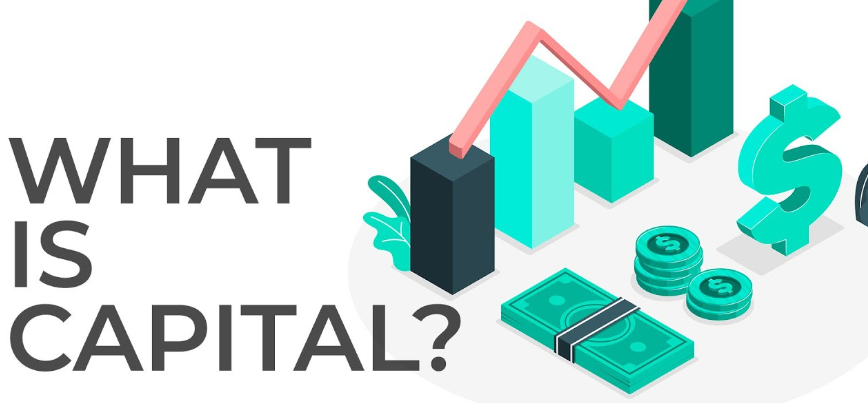What Is Capital? Everything You Need to Know
Have you ever wondered how wealth is generated, accumulated, and reinvested to drive economic growth? What is capital, and why is it considered the lifeblood of modern economies? Whether you’re an investor, a business owner, or simply curious about how financial and other forms of capital shape our society, understanding what is capital is essential. In this comprehensive guide, we’ll explore the concept of capital in depth—from its definition and key characteristics to its historical evolution, real-world applications, and modern relevance. By the end of this article, you’ll have a thorough understanding of what capital is, how it works, and why it matters in everyday life, business, and beyond.
Introduction: The Foundation of Economic Growth and Personal Wealth
Imagine a world where resources are used not only to survive but to create more value and opportunities. From the money in your savings account to the machinery in a factory, capital is the driving force behind production, innovation, and progress. Did you know that economists consider capital one of the four essential factors of production—alongside land, labor, and entrepreneurship? This means that the way we manage and invest capital can influence everything from job creation to technological advancement and even global competitiveness.
In this article, we will cover:
- A clear definition of capital and its core components.
- The essential characteristics that define what capital is, including its various forms.
- A historical and contextual background tracing the evolution of capital from ancient times to modern financial systems.
- An in-depth exploration of the different types of capital, such as financial, physical, human, social, and natural capital.
- Real-world examples and case studies to illustrate how capital is applied and managed in different industries.
- The importance, applications, and benefits of understanding capital in everyday life, business, science, culture, and global economics.
- Common misconceptions and FAQs that dispel myths and clarify the true meaning of capital.
- Modern relevance and current trends in capital formation, investment strategies, and the digital transformation of finance.
- A conclusion summarizing the key points and a call-to-action for further reading and engagement.
By the end of this guide, you’ll know exactly what is capital, why it is a cornerstone of economic and personal growth, and how you can use this knowledge to make informed decisions in your professional and personal life. Let’s begin our journey into the fascinating world of capital!
Section 1: Defining Capital
What Is Capital?
At its most fundamental level, capital refers to the resources or assets that are used to generate wealth and facilitate production. In economics, capital is not just money—it encompasses any asset that can enhance an individual’s or an organization’s ability to produce goods and services.
Straightforward Definition:
Capital is the wealth, in the form of money, assets, or resources, that is available for use in the production of more wealth. It includes tangible assets such as machinery and buildings, intangible assets such as patents and trademarks, and financial assets like stocks and bonds.
Essential Characteristics of Capital
When discussing what is capital, several key characteristics help define its nature and function:
Resource and Asset:
Capital is a resource that can be invested to produce more goods, services, or value. It serves as the foundation for economic activity.Investability:
One of the defining features of capital is that it can be invested. Whether it’s reinvesting profits into a business or allocating funds into financial markets, capital must be deployable to generate returns.Versatility:
Capital exists in multiple forms. It can be:- Financial Capital: Money, stocks, bonds, and other financial instruments.
- Physical Capital: Machinery, buildings, equipment, and infrastructure.
- Human Capital: The skills, knowledge, and experience possessed by individuals.
- Social Capital: The networks, relationships, and social trust that facilitate cooperation and economic transactions.
- Natural Capital: Natural resources such as land, water, and minerals that are utilized in production.
Productive Function:
Capital is not static; when invested wisely, it produces additional wealth. This reinvestment cycle is crucial for economic growth and development.Depreciation and Appreciation:
Over time, physical capital may depreciate (lose value) due to wear and tear, while other forms of capital, such as human capital, can appreciate through education and experience.
Understanding these characteristics provides a solid foundation for exploring the many dimensions of capital and its vital role in modern economies.
Section 2: Historical and Contextual Background
The Evolution of Capital
The concept of capital has evolved significantly over the centuries, shaped by changing economic theories, technological innovations, and societal developments.
Early Beginnings
Ancient Civilizations:
In ancient times, capital was primarily associated with tangible assets. Early civilizations, such as Mesopotamia and Egypt, relied on land, livestock, and simple tools as forms of capital to support agriculture and trade.Mercantilism and Early Trade:
During the mercantilist era (16th to 18th centuries), the accumulation of capital—often in the form of precious metals like gold and silver—was seen as the key to national wealth and power. Trade and colonial expansion were driven by the desire to acquire capital resources.
The Industrial Revolution
Transformation of Production:
The Industrial Revolution marked a dramatic shift in the concept of capital. With the advent of factories, machinery, and mass production, physical capital became central to economic growth. The ability to invest in technology and infrastructure allowed countries to rapidly expand their industrial capabilities.Financial Innovation:
This period also saw the emergence of modern financial systems. The establishment of banks, stock markets, and insurance companies created new ways to accumulate and invest capital, laying the groundwork for contemporary capitalism.
Modern Economic Theories
Capital in Neoclassical Economics:
In the 20th century, economists like Alfred Marshall and Paul Samuelson refined the concept of capital, emphasizing its role as one of the key factors of production. Neoclassical economics views capital as a critical input that, along with labor and land, determines output and economic growth.Marxist Perspectives:
Karl Marx offered a contrasting view, arguing that capital was central to the exploitation of labor and the dynamics of class struggle. His analysis of capital accumulation and the capitalist mode of production has influenced political and economic debates for over a century.
Technological and Digital Transformation
Digital Capital:
In recent decades, the rise of digital technology has given birth to a new form of capital. Digital capital includes intellectual property, data, software, and online platforms that drive modern economies. This transformation has blurred traditional distinctions between tangible and intangible assets.Globalization:
Global trade and investment have further evolved the concept of capital, making it a truly international phenomenon. Capital flows freely across borders, and global markets are interconnected in ways that were unimaginable in earlier eras.
Notable Historical Anecdotes
Adam Smith and the Wealth of Nations:
In his seminal work, The Wealth of Nations (1776), Adam Smith discussed the role of capital in economic development, laying the intellectual groundwork for modern capitalism. His ideas about the division of labor and the accumulation of capital continue to influence economic thought.Marx’s Das Kapital:
Karl Marx’s Das Kapital (1867) critically analyzed how capital is accumulated and exploited within a capitalist society. His work sparked debates about wealth distribution, labor rights, and economic inequality that persist to this day.The Dot-Com Boom:
The late 20th century witnessed a digital revolution, with companies like Microsoft, Google, and Amazon redefining capital in the digital age. The rise of digital capital has transformed how we view investments, intellectual property, and the global economy.
For more historical insights on the evolution of capital, consider reading sources such as the Encyclopedia Britannica and scholarly articles available on JSTOR.
Section 3: In-Depth Exploration of Capital
To fully grasp what is capital, we need to explore its different forms, functions, and applications in today’s economy. This section breaks down the major types of capital and illustrates their roles through real-world examples and case studies.
Types of Capital
1. Financial Capital
Definition:
Financial capital refers to the money and other financial assets that are used for investment and business operations. It includes cash, stocks, bonds, and other securities.Characteristics:
- Liquidity:
Financial capital is often liquid, meaning it can be easily converted into cash. - Investability:
It can be invested to generate further income or value. - Risk and Return:
Investments in financial capital come with varying levels of risk and potential returns.
- Liquidity:
Real-World Example:
Consider a company that raises funds by issuing stocks. This financial capital is then used to invest in new projects, hire employees, and expand operations, thereby generating additional wealth.
2. Physical Capital
Definition:
Physical capital consists of tangible assets that are used in the production of goods and services. Examples include machinery, buildings, vehicles, and equipment.Characteristics:
- Depreciation:
Physical capital can depreciate over time due to wear and tear. - Investment:
Investments in physical capital can boost productivity and efficiency. - Maintenance:
Requires ongoing maintenance and periodic upgrades.
- Depreciation:
Real-World Example:
A manufacturing plant invests in new machinery that increases production efficiency and reduces costs. This physical capital investment leads to higher output and improved profitability.
3. Human Capital
Definition:
Human capital refers to the skills, knowledge, and experience possessed by individuals. It is the collective value of an organization’s workforce.Characteristics:
- Education and Training:
Investments in education and training enhance human capital. - Productivity:
A skilled workforce can significantly increase a company’s productivity and innovation. - Adaptability:
Human capital evolves over time through learning and experience.
- Education and Training:
Real-World Example:
A tech company invests in professional development programs for its employees. As their skills improve, the company benefits from increased innovation and competitive advantage.
4. Social Capital
Definition:
Social capital encompasses the networks, relationships, and social norms that facilitate cooperation and trust among individuals and groups.Characteristics:
- Trust and Reciprocity:
Strong social networks are built on trust and mutual support. - Community Engagement:
Social capital fosters community involvement and collaboration. - Economic and Social Benefits:
High levels of social capital can lead to better economic performance and enhanced quality of life.
- Trust and Reciprocity:
Real-World Example:
A neighborhood with a strong sense of community organizes local events and supports small businesses, creating an environment where residents feel connected and supported.
5. Natural Capital
Definition:
Natural capital refers to the natural resources and environmental assets that provide ecosystem services. This includes water, air, minerals, forests, and biodiversity.Characteristics:
- Renewability vs. Nonrenewability:
Some natural resources are renewable (e.g., solar energy, forests), while others are finite (e.g., fossil fuels, minerals). - Ecosystem Services:
Natural capital provides essential services such as clean air, water filtration, and climate regulation. - Sustainability:
Sustainable management of natural capital is critical for long-term ecological balance.
- Renewability vs. Nonrenewability:
Real-World Example:
A country invests in sustainable forestry practices to ensure that its natural capital—its forests—continues to provide resources and ecological benefits for future generations.
The Role of Capital in Production and Economic Growth
Capital, in all its forms, is integral to the production process and economic development. It is the engine that drives innovation, efficiency, and growth:
Investment and Growth:
Investments in financial, physical, and human capital lead to increased productivity, higher output, and economic expansion.Wealth Creation:
Capital accumulation is essential for creating wealth at both the individual and national levels. It provides the means for businesses to innovate, expand, and compete in global markets.Risk Management:
Different forms of capital help manage risks. For example, diversified financial capital portfolios can mitigate investment risks, while investments in human capital can drive adaptability in changing economic landscapes.
Real-World Case Studies
Case Study 1: The Rise of Silicon Valley
Overview:
Silicon Valley is a prime example of human and financial capital working together to create unprecedented economic growth. The region’s concentration of skilled workers, venture capital investment, and technological innovation has led to the birth of some of the world’s most influential companies.Impact:
Silicon Valley’s success demonstrates how investing in human capital (through education and training) and financial capital (through venture capital funding) can drive technological advancements and economic prosperity.Key Takeaway:
The synergy between different forms of capital is crucial for fostering innovation and sustaining economic growth.
Case Study 2: Natural Capital and Sustainable Development in Scandinavia
Overview:
Scandinavian countries, known for their commitment to sustainability, have successfully integrated natural capital into their economic models. By investing in renewable energy, sustainable forestry, and environmental protection, these nations have created robust economies that prioritize both growth and ecological preservation.Impact:
The emphasis on natural capital has led to cleaner environments, higher quality of life, and long-term economic stability.Key Takeaway:
Sustainable management of natural capital is not only environmentally responsible but also economically beneficial.
Case Study 3: The Global Financial Crisis and the Importance of Financial Capital
Overview:
The global financial crisis of 2008 highlighted the critical role of financial capital and the risks associated with its mismanagement. The collapse of major financial institutions underscored the importance of sound investment strategies and risk management.Impact:
In the aftermath, governments and institutions worldwide implemented reforms to strengthen financial systems, emphasizing the need for transparency and responsible capital allocation.Key Takeaway:
Proper management of financial capital is essential for economic stability and growth, and lessons from the crisis continue to shape global financial policies.
Section 4: Importance, Applications, and Benefits of Understanding Capital
The Crucial Role of Capital in Everyday Life
Understanding what is capital is essential because capital is the engine behind economic and social progress. Here are some of the key reasons why capital matters:
Economic Foundations
Driving Production:
Capital is one of the four primary factors of production. It provides the resources needed for manufacturing, agriculture, and service industries, directly contributing to a nation’s GDP and overall economic health.Wealth Accumulation:
Individuals and businesses accumulate capital to invest in opportunities that generate additional wealth, fostering economic growth and financial stability.
Social and Cultural Impact
Improving Quality of Life:
Investments in capital, whether in education, infrastructure, or technology, improve the quality of life by creating jobs, enhancing public services, and enabling innovation.Cultural and Social Capital:
Beyond financial and physical capital, social and cultural capital play a significant role in shaping communities and fostering social cohesion. These forms of capital contribute to a society’s cultural richness and collective identity.
Business and Innovation
Supporting Entrepreneurship:
Access to capital is crucial for entrepreneurs looking to launch new ventures. It fuels innovation, supports startup growth, and drives technological advancements.Competitive Advantage:
Companies that effectively manage and invest their capital are better positioned to compete in global markets, adapt to changing conditions, and sustain long-term growth.
Applications Across Different Domains
In Education
Academic Investment:
Educational institutions rely on various forms of capital—financial, human, and physical—to enhance learning environments, fund research, and support student development.Scholarships and Grants:
Access to capital in the form of scholarships and grants empowers students to pursue higher education and unlock their potential, contributing to human capital development.
In Business and Industry
Corporate Investments:
Companies invest in physical capital such as machinery and technology to boost productivity, while financial capital is used to fund innovation and expansion.Workforce Development:
Investment in human capital through training and education is essential for improving employee skills, driving efficiency, and fostering a culture of continuous improvement.
In Public Policy and Global Development
Infrastructure Projects:
Governments rely on capital investments to build and maintain infrastructure such as roads, bridges, and public utilities. These projects not only create jobs but also lay the foundation for economic growth.Sustainable Development:
Managing natural capital responsibly is key to ensuring long-term environmental sustainability. Policies that promote renewable energy, sustainable agriculture, and conservation efforts are critical for a healthy planet.
In Everyday Life
Personal Finance:
On an individual level, understanding capital helps you manage your finances, invest wisely, and plan for the future. Personal capital accumulation through savings, investments, and education can lead to greater financial independence.Community Building:
Social capital is a vital component of community development. Strong social networks and trust among community members contribute to social stability and collective well-being.
For more insights into the significance and applications of capital, consider exploring resources such as the World Bank and Investopedia.
Section 5: Common Misconceptions and FAQs About Capital
Debunking Common Misconceptions
Despite its importance, several misconceptions about what is capital persist. Let’s address some common myths:
Misconception #1: Capital Is Only About Money.
Reality:
Capital is much broader than money. It includes physical assets (machinery, buildings), human capital (skills, education), social capital (networks, relationships), and natural capital (land, water, minerals).Misconception #2: All Capital Is Easily Replenishable.
Reality:
While some forms of capital, like human capital and certain renewable natural resources, can be replenished over time, others, such as fossil fuels and minerals, are finite. Sustainable management is essential.Misconception #3: Capital Only Benefits the Wealthy.
Reality:
Efficient management and distribution of capital are crucial for economic growth and can lead to broad societal benefits, such as job creation, improved infrastructure, and enhanced public services.Misconception #4: Capital Is Static and Unchanging.
Reality:
Capital is dynamic. It can appreciate, depreciate, and be reinvested. Its value and function change over time based on economic conditions, technological advancements, and social factors.
Frequently Asked Questions (FAQs)
Q: What is capital?
A: Capital is the wealth or assets that are used to produce more wealth. It includes financial resources, physical assets, human skills, social networks, and natural resources.Q: How does capital differ from money?
A: While money is one form of capital, capital itself is a broader concept that includes all resources used in production and wealth creation, such as machinery, education, relationships, and natural resources.Q: Why is capital important in an economy?
A: Capital is essential for production, investment, and economic growth. It provides the means for businesses to expand, innovate, and generate profits, which in turn drives overall economic development.Q: What are the different types of capital?
A: The main types of capital include financial capital, physical capital, human capital, social capital, and natural capital. Each type plays a unique role in supporting economic and social activities.Q: How can individuals benefit from understanding capital?
A: Understanding capital helps individuals make informed financial decisions, invest wisely, and appreciate the broader economic forces that impact their lives. It also promotes better resource management and personal growth.
Section 6: Modern Relevance and Current Trends in Capital
Capital in the 21st Century
In today’s rapidly changing global economy, understanding what is capital is more relevant than ever. Advances in technology, globalization, and shifts in economic models continue to reshape the landscape of capital.
Technological Innovations and Digital Capital
Digital Transformation:
The rise of digital technology has given birth to a new form of capital: digital capital. This includes data, intellectual property, and online platforms, which are now central to modern economies. Companies like Google, Apple, and Facebook derive significant value from their digital assets.Automation and AI:
Investments in automation and artificial intelligence represent a blend of physical, financial, and human capital. These technologies are driving productivity gains and reshaping industries, highlighting the evolving nature of capital in the digital era.
Globalization and Capital Mobility
Cross-Border Investments:
In today’s interconnected world, capital flows freely across borders. Global investors seek opportunities in emerging markets, and multinational corporations leverage diverse sources of capital to drive growth.Economic Integration:
Organizations like the International Monetary Fund (IMF) and the World Bank work to promote the efficient allocation of capital on a global scale, ensuring that financial resources contribute to sustainable development.
Sustainability and Natural Capital
Environmental Concerns:
The concept of natural capital has gained prominence as society recognizes the finite nature of environmental resources. Sustainable management of natural capital is now a key focus in global discussions about climate change, conservation, and economic development.Green Finance:
Innovations in green finance—such as green bonds and sustainable investment funds—are helping channel capital toward environmentally friendly projects, demonstrating the integration of economic and environmental objectives.
Social and Cultural Shifts
Inclusive Capitalism:
There is a growing emphasis on inclusive capitalism, which seeks to ensure that capital benefits all members of society, not just a privileged few. This shift is influencing corporate governance, investment strategies, and public policy.Entrepreneurial Spirit:
Startups and small businesses are increasingly seen as vital engines of economic growth. Access to capital, in its many forms, is crucial for innovation and job creation, driving a dynamic entrepreneurial ecosystem.
For further reading on modern capital trends, sources such as the World Economic Forum and The Economist provide up-to-date analyses and insights.
Section 7: Practical Applications and Benefits of Understanding Capital
Everyday Benefits and Personal Empowerment
Understanding what is capital equips you with the knowledge to navigate personal finance, make smarter investment choices, and appreciate the broader economic forces at play:
Financial Planning:
By understanding financial capital, you can better manage your savings, investments, and spending. This knowledge helps in creating a stable financial future and achieving long-term goals.Career and Education:
Investing in human capital—through education and skills development—can boost your career prospects and personal growth. Recognizing the value of human capital empowers you to invest in yourself.Community and Social Networks:
Social capital is key to building strong relationships and networks. By understanding its importance, you can foster connections that provide support, opportunities, and a sense of belonging.Sustainable Living:
Awareness of natural capital encourages environmentally responsible behaviors, such as conserving resources and supporting sustainable practices. This not only benefits the planet but also improves your quality of life.
Applications in Various Domains
In Education
Curriculum Enhancement:
Integrate lessons on capital—financial, human, physical, social, and natural—into academic curricula to build a comprehensive understanding of economics and resource management.Interactive Learning:
Utilize case studies, simulations, and project-based learning to help students understand how capital works in real-world scenarios, from small businesses to large multinational corporations.
In Business and Industry
Investment Strategies:
Businesses rely on efficient capital management to drive growth and innovation. Understanding different types of capital helps companies optimize their operations, reduce waste, and invest in future opportunities.Corporate Governance:
A robust grasp of capital is crucial for effective decision-making in corporate governance. Companies that manage capital wisely are better positioned to achieve long-term success and resilience.
In Public Policy and Global Development
Economic Policy:
Governments use the concept of capital to design policies that promote sustainable growth, reduce inequality, and improve public services. Effective capital management is essential for infrastructure development, healthcare, education, and environmental conservation.International Cooperation:
Global institutions and treaties that focus on capital flows and resource management are critical for fostering economic stability and sustainable development worldwide.
In Everyday Life
Consumer Empowerment:
Understanding capital helps you make informed decisions about purchases, investments, and savings. It encourages you to consider not only the cost but also the long-term value of your choices.Personal Growth:
By investing in your own human capital through education and skill development, you enhance your potential and open up new opportunities for success and fulfillment.
For additional practical tips on capital management, resources such as Investopedia and The Balance offer comprehensive guides on personal finance and economic fundamentals.
Section 8: Conclusion and Call-to-Action
Summarizing the Essentials
So, what is capital? Capital is the wealth, in the form of money, assets, and resources, that is used to generate further wealth. It encompasses financial capital, physical capital, human capital, social capital, and natural capital. Throughout this guide, we have:
- Provided a clear definition of capital and explained its key characteristics.
- Explored the historical evolution of capital from ancient resource management to modern financial systems.
- Delved into an in-depth exploration of the various types of capital, offering real-world examples and case studies that illustrate their roles in production, innovation, and economic growth.
- Highlighted the importance, applications, and benefits of understanding capital in everyday life, business, education, public policy, and global development.
- Addressed common misconceptions and FAQs to clarify what capital is and dispel myths about its nature.
- Discussed modern relevance and current trends that demonstrate how technology, globalization, and sustainability are reshaping our understanding and management of capital.
The Importance of Understanding Capital
Understanding what is capital is crucial for making informed decisions that affect your personal finances, career, and the broader economic landscape. Whether you’re investing in a business, planning your financial future, or shaping public policy, a deep comprehension of capital empowers you to harness its potential for growth and development. It is the engine that drives production, innovation, and societal progress.
Call-to-Action
Now that you have a comprehensive understanding of capital, here are some steps you can take to further engage with this essential topic:
Educate Yourself Further:
Explore additional resources on capital by visiting reputable websites such as Investopedia and World Bank. Read books on economic theory, such as Adam Smith’s “The Wealth of Nations” or Karl Marx’s “Das Kapital”, to gain historical and theoretical perspectives.Apply Your Knowledge:
Use your understanding of capital to evaluate your personal finances, investments, and career choices. Consider creating a financial plan or portfolio that reflects the principles of effective capital management.Engage in Discussions:
Join forums, webinars, or local groups focused on economics, finance, and real estate. Engaging in discussions can provide diverse perspectives and help deepen your understanding.Share This Guide:
If you found this post informative, please share it on social media, with colleagues, or with anyone interested in economics and financial literacy. Spreading the word about what is capital can help others make better-informed decisions.Subscribe for More:
Stay updated on the latest research, trends, and practical tips in economics and finance by subscribing to our newsletter. Join our community of lifelong learners committed to understanding the forces that drive our global economy.
By taking these steps, you will not only enhance your own understanding of capital but also contribute to a more informed and economically empowered society.
Final Thoughts
Capital is much more than just money—it is the foundation of economic growth, innovation, and societal progress. Understanding what is capital equips you with the tools to navigate the complexities of the modern world, from personal finance to global economic policies. As you continue your journey into the realms of finance and economics, remember that effective capital management is key to unlocking new opportunities and achieving long-term success.
Thank you for taking the time to explore this comprehensive guide on capital. We hope it has provided you with valuable insights and practical knowledge that will inspire you to make informed decisions and invest in a brighter future.
For further reading and additional resources on capital, please visit:
- Investopedia – What is Capital?
- World Bank – Natural and Human Capital
- Harvard Business Review on Capital Investment
If you found this guide helpful, please share it on social media, leave your feedback in the comments below, and subscribe to our newsletter for more in-depth articles on economics, finance, and business strategies.
Let’s harness the power of capital to build a stronger, more prosperous future—one informed decision at a time.
Happy investing, and stay empowered!







